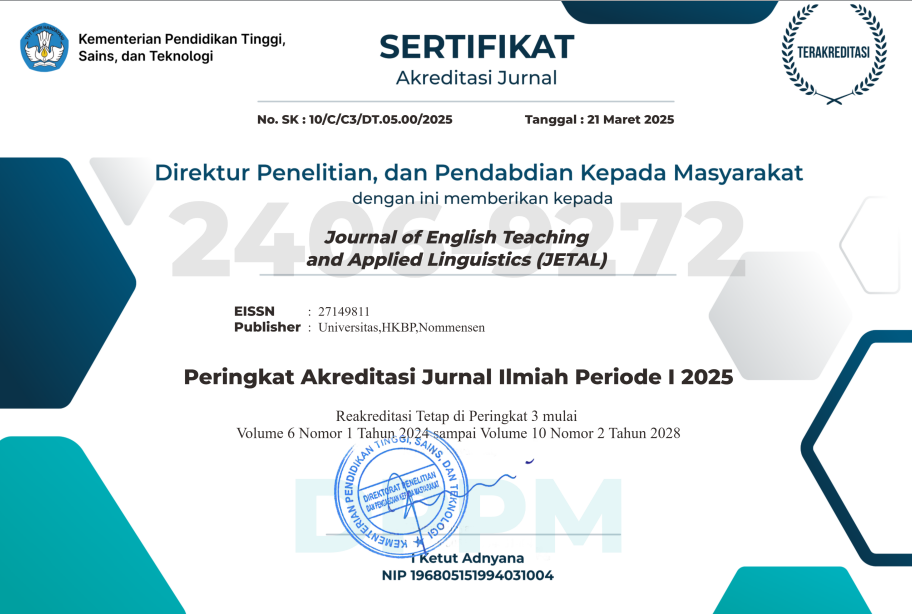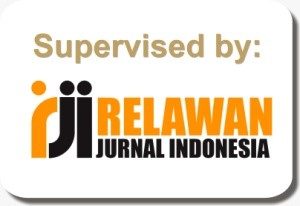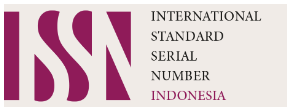EFL Students in Speaking Skill: Identifying English Education Students’ Perceptions of the Psychological Problems in Speaking
Abstract
This research focuses on students' English speaking problems, and this research aims to find out the most dominant problem of speaking in English as a Foreign Language (EFL) situation faced by the students of English Departement at Tidar University. The research method used in this research is the qualitative method. The writer uses a questionnaire as a tool for data collection. From the questionnaire, the problems that most dominant faced by the English education students of the English Department at Tidar University is Linguistic problems. Linguistic problems include less grammar, lack of vocabulary, and poor pronunciation. The next is psychological problems include, including lack of self-confidence, anxiety, and shyness. Meanwhile, instructor related problems did not have much effect on speaking problems for the students. In conclusion, Linguistic problems are the most dominant problem faced by the English education students of the English Department at Tidar University.
References
Brown, H. D. (2007). Teaching by Principles, Second Edition. Teaching by Principles An Interactive Approach to Language Pedagogy.
Cam, L., & Tran, T. M. T. (2017). An evaluation of using games in teaching English grammar for first year English-majored students at Dong Nai Technology University. International Journal of Learning, Teaching and Educational Research, 16(7), 55–71. Retrieved from https://pdfs.semanticscholar.org/ea44/48f1c6cbb8dab7420abbd20a993a86728206.pdf
Celce-Murcia, M. (2007). Rethinking the role of communicative competence in language teaching. In Intercultural Language Use and Language Learning. https://doi.org/10.1007/978-1-4020-5639-0_3
Fitriani, D. A., Apriliaswati, R., & Wardah. (2015). A Study on Student’ s English Speaking Problems in Speaking Performance. Jurnal Pendidikan Dan Pembelajaran Untan.
Harmer, J. (2007). The Practice of English Languag Teaching. 394–409.
Hinkel, E. (2011). Handbook of research in second language teaching and learning. In Handbook of Research in Second Language Teaching and Learning. https://doi.org/10.4324/9780203836507
Musthafa, B. (2001). Communicative language teaching in Indonesia issue of theoretical assumption and challenges in the classroom practice. Journal of Southeast Asian Education, 2.
Quinn Patton, M., & Cochran, M. (2007). A Guide to Using Qualitative Research Methodology. In Medecins Sans Frontieres. Retrieved from http://msf.openrepository.com/msf/handle/10144/84230
Riadil, I. G. (2020). DOES ORAL PRESENTATION AFFECT THE DEVELOPMENT OF THE STUDENTS ’ ABILITY TO SPEAK IN EFL CLASSROOM ? Social Sciences, Humanities and Education Journal (SHE Journal), 1(2), 13–21. https://doi.org/10.25273/she.v1i2.6622
Richards, J. C., & Schmidt, R. (2010). Longman dictionary of language teaching & applied linguistics. In Proceedings of the 21st Asian Pacific Weed Science Society (APWSS) Conference, 2-6 October 2007, Colombo, Sri Lanka. Retrieved from http://images.pcmac.org/Uploads/JeffersonCountySchools/JeffersonCountySchools/Departments/DocumentsSubCategories/Documents/English - Dictionary of Language Teaching and Applied Linguistics.pdf
Authors retain copyright and grant the journal right of first publication with the work simultaneously licensed under a Creative Commons Attribution-ShareAlike 4.0 International License (CC BY-SA 4.0) that allows others to share the work with an acknowledgment of the work's authorship and initial publication in this journal.
Authors are able to enter into separate, additional contractual arrangements for the non-exclusive distribution of the journal's published version of the work (e.g., post it to an institutional repository or publish it in a book), with an acknowledgment of its initial publication in this journal.
Authors are permitted and encouraged to post their work online (e.g., in institutional repositories or on their website) prior to and during the submission process, as it can lead to productive exchanges, as well as earlier and greater citation of published work (See The Effect of Open Access).






